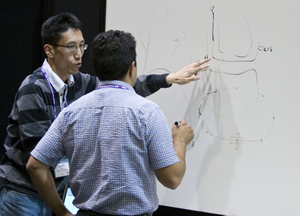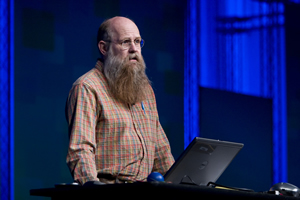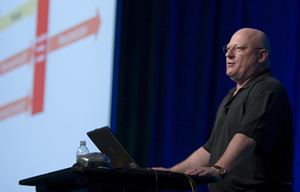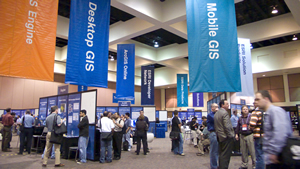Attendees Get a Glimpse of ArcGIS 9.3
By David Martinez, Esri Product Marketing
 The DevSummit promotes an exchange of ideas. |
More than 1,200 developers from 49 countries attended the 2008 Esri Developer Summit, where they previewed Esri's next release: ArcGIS 9.3.
The three-day summit in Palm Springs, California, gave them a firsthand look at the ArcGIS 9.3 platform. Discussions and demonstrations focused on tips, best practices, and techniques for building and deploying server-based, Web, and mobile applications.
"The ability to directly interact with the Esri development team is invaluable-there is no quicker way of identifying and solving problems or getting advice," James Tedrick, a GIS specialist for the Maryland National Capital Park and Planning Commission (M-NCPPC), said about the value of attending.
The developers also listened to a keynote talk by Alan Cooper, who runs the consulting company Cooper and is sometimes called "the father of Visual Basic."
Esri ArcGIS program manager Jim McKinney welcomed the developers and provided an overview of the ArcGIS 9.3 enhancements. The improvements, he said, will include better performance, security, and documentation along with new resource centers. New JavaScript and REST APIs also will let developers easily access services provided by ArcGIS Server.
 The 2008 Esri Developer Summit drew a crowd of more than 1,200 people to the Palm Springs Convention Center. |
"ArcGIS 9.3 is a follow-on to the 9.2 release," Scott Morehouse, director of Software Development at Esri, told the audience during the opening plenary session. "The primary objective of ArcGIS 9.3 has been to complete concepts and capabilities introduced at 9.2."
Web Emphasis
"The 9.3 platform places a much greater emphasis on the Web," said Morehouse. "The technology platform for GIS has evolved over the years. Initially, the focus was on leveraging minicomputers and workstations with an emphasis on high-performance computing and end-user interactivity. Then, the focus shifted to the database with an emphasis on information modeling and transactional data management. Now, the focus is on the Web. We have been working to put the Web at the center of everything that we're doing with the ArcGIS system."
Morehouse said Esri has worked to bring the Web-centric perspective into all aspects of the system—not just the browser-based software but also ArcGIS Desktop and ArcGIS Engine. He said the Web means
- A loosely coupled network architecture that allows different systems to interoperate in a federated fashion.
- Lots of searchable content available on demand in a ready-to-use format: "We've put a lot of work into making content available for the ArcGIS system as a whole."
- Something easy to use: "I think people now have an expectation of simple access to information. They expect to be able to focus on their main job and not get stuck operating complex computer software."
- Certain programming patterns and APIs: "You can see this most clearly with JavaScript and mashup techniques."
- Participating in a larger ecosystem: "GIS is not a closed environment. It's a system that leverages and works with broader consumer, media, and enterprise technologies."
JavaScript and REST APIs
 Scott Morehouse, director of Software Development at Esri, told developers that the ArcGIS 9.3 platform will place a greater emphasis on the Web. |
Esri showcased the new APIs at the Plenary Session and in technical sessions presented by the ArcGIS engineers who developed them. In the REST API session, developers packed the room to see demonstrations of how to use JavaScript, Python, Ruby, and Yahoo! Pipes to access back-end REST services powered and published by ArcGIS Server. All resources and operations exposed by the REST API are accessible through a URL.
Demonstrations in the ArcGIS API for JavaScript session showed how mashups can be built using JavaScript with REST that add map layers and tasks from ArcGIS Server to Google Maps and Microsoft Virtual Earth. The JavaScript API comes in three "flavors": ArcGIS API for JavaScript, ArcGIS JavaScript Extension for Microsoft Virtual Earth, and ArcGIS JavaScript Extension for Google Maps.
At the Plenary Session, Esri staff reviewed what enhancements GIS users will see in ArcGIS Engine and ArcGIS Explorer. ArcGIS Engine 9.3 will include improved dynamic display with better display caching. ArcGIS Engine also will include Microsoft SQL Server Express, allowing developers to use geodatabases stored in SQL Server Express as a data source.
The plenary demonstration of ArcGIS Explorer showed some new enhancements to look forward to in build 480. These include multithreaded performance increases, direct connection to ArcSDE, GPX support, Geographically Encoded Objects for RSS feeds (GeoRSS) support, and improved task frameworks. The audience received a glimpse of the direction of future improvements to ArcGIS Explorer such as a new ribbon user interface. ArcGIS Explorer users will also be able to view maps in 2D or 3D models.
At the end of the Plenary Session, Esri introduced its new resource centers for the ArcGIS products. Each ArcGIS product will have a resource center that centralizes all the information needed to be successful such as code samples, blogs, interactive software developer kits (SDKs), and documentation. Documentation in general will be improved with the ArcGIS 9.3 release.
Alan Cooper on Software Design
 Alan Cooper, a pioneering software inventor, programmer, designer, and theorist, gave the keynote presentation. |
A pioneering software inventor, designer, and theorist, Cooper opened his talk with an anecdote about his experience (albeit limited) with GIS about 15 years ago. "My work never saw the commercial light of day," he said, adding, however, that he still considers himself part of the community. "Jim [McKinney of Esri] just handed me a T-shirt that says 'Geo Geek,' and I will proudly wear it because I think of myself as a geo geek," he commented.
His talk focused on how to solve what he considers the number one problem in software design today. "It turns out that organizations that build software don't know how to integrate design from people who know how to do design," he said. "Management change is necessary to allow organizations that build and produce software to integrate the design process-I call it postindustrial management."
For example, he believes interaction designers should determine what must be built, design engineers should decide how software should be constructed, and production engineers should actually build the software. Cooper's presentation was well received, and he spent approximately 45 minutes after his presentation fielding questions from a large group of developers who chose to stay.
Technical Sessions Popular
This year, there were more than 40 technical sessions available to attendees, followed by informal "tech talks." These focused sessions, which were well attended, provided best practices, tips, sample code, live demonstrations, and new features of ArcGIS 9.3.
Some of the key messages from the sessions related to the Web Application Developer Framework (ADF) and ArcGIS Mobile. For example:
- The Web ADF in ArcGIS 9.3 is a hybrid development platform that offers a well-balanced combination of client and server logic rather than only server logic. With the release of ArcGIS 9.3, it will be fully integrated with the Microsoft ASP.NET AJAX library. It will have faster map blending, more client-side logic, and support for Visual Studio 2008. Also, the Web controls have been enhanced and are scriptable, which extends the ASP.NET AJAX client-side functionalities.
- ArcGIS Mobile 9.3 will include an out-of-the-box configurable application. A new mobile toolset has been added to ArcGIS Desktop ArcToolbox to support building data deployment packages for ArcGIS Mobile. This includes the Mobile Base Map tool and the Generate Service Cache tool, which let users easily create basemap datasets and a mobile service cache for all operational layers. Also, to fit in with the ArcGIS Server 9.3 security model, ArcGIS Mobile has been updated to support token-based security.
 Developers visited the Esri Showcase islands, where they watched software demonstrations and asked the staff questions. |
Many attendees enjoyed the technical sessions and the informal tech talks that followed. "To be able to confer with the people that are actually developing the software that we are working with is a tremendous advantage . . . both to be able to solve current issues and to understand their mindsets on the construction and expected performance of the software," said Leah Twombly from Bartlett & West.
Esri development leads, product managers, and senior-level directors hosted a question-and-answer session on the last day of the summit. That gave attendees the opportunity to ask questions and make suggestions regarding improvements to the summit, service pack updates, and anything related to ArcGIS products.
"Meeting with the Esri developers and staff one on one is by far the best thing about the summit," commented Tom Rippetoe from CH2M HILL.
Those who were unable to attend the summit can download the technical presentations, audio/screen capture recordings, and sample code from the Esri Developer Network (EDN) Web site.